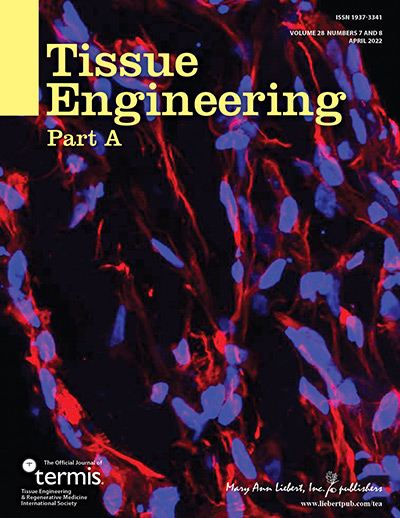For Immediate Release
New Strategies for Engineering Stable Articular Cartilage
Contact: Paige Casey
914-740-2100
pcasey@liebertpub.com

New Rochelle, NY, April 28, 2022—A new study assess the effect of the gremlin-1 (GREM1) protein on the in vitro and in vivo stability of bone marrow stem cell (BMSC)-derived cartilage engineered within scaffolds. The study design and results are reported in the peer-reviewed journal Tissue Engineering, Part A. Click here to read the article now
A major challenge associated with MSC-derived cartilage is that the cells tend to undergo hypertrophic differentiation, yielding tissue unsuitable for use in articular cartilage repair. New tissue engineering strategies are needed to generate stable chondrocyte-like cells from BMSCs. In this study, Daniel Kelly, from Trinity College, and coauthors, treated BMSCs seeded onto scaffolds with GREM1, which is a glycoprotein that inhibits bone morphogenetic proteins (BMPs). BMPS are capable of inducing endochondral bone formation. The investigators found that GREM1 suppressed the expression of known hypertrophic markers and slowed the turnover of engineered cartilage tissue in vivo. However, it did not prevent endochondral ossification from occurring in vivo.
“The results of this study demonstrate that cartilage constructs engineered in the presence of GREM1 are more resistant to matrix degradation and turnover upon subcutaneous implantation, although stimulation with such BMP antagonist in vitro does not prevent regions of the tissue undergoing endochondral ossification in vivo,” concluded the investigators.
“Dr. Kelly and colleagues at Trinity College Dublin (Ireland) nicely show that a key regulator of articular cartilage physiology (GREM1) can be utilized to suppress cartilage hypertrophy/endochondral ossification, while supporting healthy markers, within engineered tissues. Although this approach does not completely eliminate degeneration, the work here establishes an exciting potential pathway for engineering truly viable cartilage tissues,” says Tissue Engineering Co-Editor-in-Chief John P. Fisher, PhD, Fischell Family Distinguished Professor & Department Chair, and Director of the NIH Center for Engineering Complex Tissues at the University of Maryland.
About the Journal
Tissue Engineering is an authoritative peer-reviewed journal published monthly online and in print in three parts: Part A, the flagship journal published 24 times per year; Part B: Reviews, published bimonthly, and Part C: Methods, published 12 times per year. Led by Co-Editors-in-Chief Antonios G. Mikos, PhD, Louis Calder Professor at Rice University, Houston, TX, and John P. Fisher, PhD, Fischell Family Distinguished Professor & Department Chair, and Director of the NIH Center for Engineering Complex Tissues at the University of Maryland, the Journal brings together scientific and medical experts in the fields of biomedical engineering, material science, molecular and cellular biology, and genetic engineering. Leadership of Tissue Engineering Parts B (Reviews) and Part C (Methods) is provided by Katja Schenke-Layland, PhD, Eberhard Karls University, Tübingen and John A. Jansen, DDS, PhD, Radboud University, respectively. Complete tables of content and a sample issue may be viewed online at the Tissue Engineering website. Tissue Engineering is the official journal of the Tissue Engineering & Regenerative Medicine International Society (TERMIS). Complete tables of content and a sample issue may be viewed on the Tissue Engineering website.
About the Publisher
Mary Ann Liebert, Inc., publishers is known for establishing authoritative peer-reviewed journals in many promising areas of science and biomedical research. Its biotechnology trade magazine, GEN (Genetic Engineering & Biotechnology News), was the first in its field and is today the industry’s most widely read publication worldwide. A complete list of the firm’s more than 100 journals, books, and newsmagazines is available on the Mary Ann Liebert, Inc., publishers website.